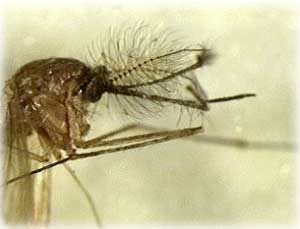 by Hector Douglas September 03, 2004
In less than six years West Nile virus has reached all the way across the United States from New York City to Los Angeles. West Nile virus, also known as WNV, has showed up in all but a few states. But can West Nile virus travel north to Alaska? The answer depends on the biology of birds and mosquitoes, says James Kruse, an entomologist with the U.S. Forest Service in Fairbanks. James Kruse said, "The disease needs to replicate in the salivary glands of the mosquito and then the mosquito needs to go forth and bite new birds. Once the bird is sick, that is when other mosquitoes can bite it, and the disease would be transferred to those new mosquitoes." The virus extends its range when wild birds contract WNV during migration and carry it into new areas. This summer, West Nile virus has expanded into central Canada. That has some scientists wondering whether WNV could make its way to Alaska-including scientists like Louisa Castrodale, an epidemiologist with the State Health Department. She says a lot of events would have to line up for an outbreak of West Nile virus to occur. Louisa Castrodale said, "Can we get a bird up here with virus? Can the mosquito bite the bird and pick up enough virus? Can the mosquito live long enough to amplify this virus? Is that mosquito the same kind of mosquito that likes to bite a human? So if you can get all those lined up together, that's when we would see it up here." Castrodale helps coordinate the state's interagency monitoring program for West Nile virus. As part of that program, they are keeping a lookout for dead birds. Studies have shown that certain species of birds like ravens, magpies, jays, and hawks start dropping dead when West Nile virus moves into an area. Castrodale said, "What we are focusing on is that family of birds that include the crows and the magpies and the jays, and looking for evidence that they have the virus, and that is going to give us an indication of whether it could spill over into the human population." Don Ritter is former head of the Alaska State Virology Lab, which diagnoses the gamut of public health diseases from rabies and flu to HIV. Last year the lab analyzed 22 dead birds from around the state. They extracted genetic material from the birds' brains and amplified Ritter said, "The virus antibodies that we are looking for is called an IGM. And that particular type of antibody is quite large and complex." The size and complexity of the IGM antibody helps to document exposure, but an additional test is required to confirm presence of West Nile virus. That test is performed by the Centers for Disease Control and Prevention in Fort Collins, Colorado. Last year, the labs in Alaska and Colorado confirmed two human cases of West Nile virus, but these were visitors, not Alaskan residents. They became ill with symptoms of WNV while in Alaska, but they had been exposed to areas with infected mosquitoes in the Lower 48 before coming on their trip north. According to the state health department there is no evidence, either from the humans or birds tested to date, that West Nile virus is active in Alaska. James Kruse of the Forest Service doesn't think West Nile virus will become established in Alaska. He says conditions here are just not right. Only four out of the 35 mosquito species in Alaska are known to transmit West Nile virus. Lots of those mosquitoes have to bite lots of infected birds in order for the virus to spread, but mosquitoes in Alaska produce just one generation per year. Kruse said, "Therefore there's limited opportunity for the disease to ramp up in the bird population through repeated mosquito attacks throughout the summer." Kruse says that even if a sick bird arrives in Alaska, few mosquitoes have emerged in early spring when migratory birds are making their way across the state. And West Nile virus is not spread to mosquitoes after about 10 days from the time the bird is bitten. Kruse says that this would limit transmission of the disease between birds and mosquitoes, and therefore limit the spread of West Nile virus.
This story is courtesy of Arctic
Science Journeys, a production of the Alaska Sea Grant Program
at the University of Alaska Fairbanks School of Fisheries and
Ocean Sciences.
|
|||
